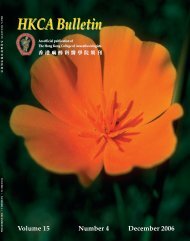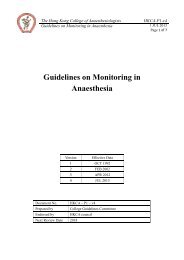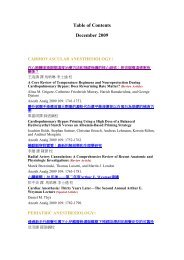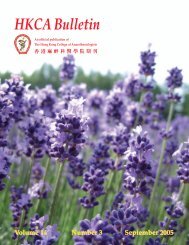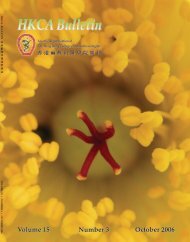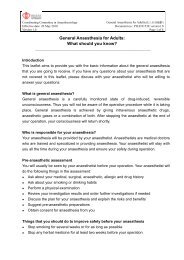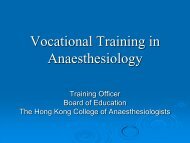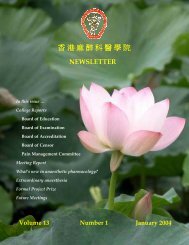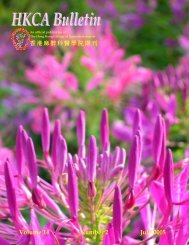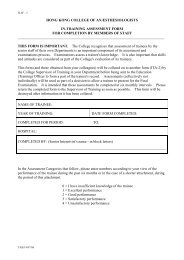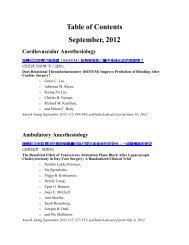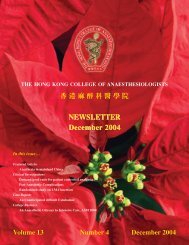Oct03.draft v2 - The Hong Kong College of Anaesthesiologists
Oct03.draft v2 - The Hong Kong College of Anaesthesiologists
Oct03.draft v2 - The Hong Kong College of Anaesthesiologists
You also want an ePaper? Increase the reach of your titles
YUMPU automatically turns print PDFs into web optimized ePapers that Google loves.
<strong>Hong</strong> <strong>Kong</strong> <strong>College</strong> <strong>of</strong> <strong>Anaesthesiologists</strong>Message from the President
Board <strong>of</strong> ExaminationIntermediate Fellowship Examinations, August 2003Successful candidates:CHANG Hang KwokFUNG Chi Sum WinnieKONG Kau Fung VincentWONG Kan NamLEE Ka Yee PhoebeYEUNG Lok See CherylKWHQEHDKHPMHPWHPWH<strong>The</strong> <strong>College</strong> is grateful to Dr. David Green <strong>of</strong> RCA, and Dr. James Love <strong>of</strong> ANZCA for theirassistance as External Examiners during the examination.Final Fellowship Examinations, September 2003<strong>The</strong> written section and viva examination was held at the <strong>Hong</strong> <strong>Kong</strong> Academy <strong>of</strong> MedicineBuilding. <strong>The</strong> OSCE was held in the Prince <strong>of</strong> Wales HospitalSuccessful candidates:(Left to right: Drs. David Chong, Winnie Chan, …., Benny Cheng, Peggy Pang, …., Lina …., …., ….., Peter Booker, DavidScott, Cindy Aun, ….., Raymond Sin, SS Ho, Eric Ung )<strong>The</strong> <strong>College</strong> is grateful to Dr. Peter Booker <strong>of</strong> RCA, and Dr. David Scott <strong>of</strong> ANZCA for theirassistance as External Examiners during the examination.Cindy AunChairman, Board <strong>of</strong> Examination
<strong>The</strong> OSCE …Regional (Drs. YF Chow and Cindy Lai)Crisis (Drs. Matthew Chan, David Scottand Steven Wong)Physical Examination(Drs. Simon Chan, Andrea O’Regan, Peter Booker and TW Lee)
Procedure (Drs. CT Hung and BH Yong)X Ray (Drs. PW Cheung and CK Chan)Investigations (Drs. Victor Yeo and Serena Fung)ACLS/ATLS (Drs. Edward Ho and Anthony Ho)Equipment (Dr. Kevin Mui)Communication (Drs. <strong>The</strong>resa Hui and CK Koo)Mr Daniel TsoAdministrative executive,HKCA
More happy faces …
Board <strong>of</strong> Accreditation<strong>The</strong> <strong>College</strong> has recently re-inspected Kwong Wah Hospital. <strong>The</strong> Council has resolved that thenumber <strong>of</strong> trainee positions be increased from 10 to 12 for 2 years. It is also recommended thatthe recognition <strong>of</strong> three months <strong>of</strong> intensive care component <strong>of</strong> anesthesiology training becontinued.John LiuChairman, Board <strong>of</strong> Accreditation
Board <strong>of</strong> CensorNew FellowsAdmission to Fellowship by Examination , FHKCAKing Yuen MANKarman Ka Lai NGHa Yun LEEJoanne Chung Yin LEEMan Shun LAWChing Yee KWOKEric Mo Chi LAMAdmission to Fellowship ad eundem, FHKCASong Tuen TANAngel On Kei WONGAdmission to Fellowship by Examination , FHKCA (Intensive Care)Kenny King Chung CHANAdmission to Fellowship ad eundem, FHKCA (Intensive Care)Judith SHENAnne Kit Hung LEUNGNew MembersWing Yan LEUNGBetty Wai Yee CHEUNGBelinda Lai Yee WONGCMCQMHPWHMichael IrwinChairman, Board <strong>of</strong> Censor
Pain Management Committee<strong>The</strong> next Dip Pain Examination will be held on Oct 17 th 2003. Dr Bruce Rounsefell, from Adelaidewill be our external examiner. Details <strong>of</strong> the Pain Examiner's academic programme will beannounced close to his visit. As SARS has abated somewhat, the Pain Management Committee isplanning to resume its CME programme and organise a meeting sometime late in June or earlyJuly.As mentioned in the President's message at the AGM, PYNEH has been accredited for six months<strong>of</strong> training towards Dip Pain Mgt. <strong>The</strong> other half <strong>of</strong> the training can be spent at anotheraccredited local training centre or overseas. However, the accreditation <strong>of</strong> overseas training mustbe assessed by the Pain Management Committee, and approved by the HKCA Board <strong>of</strong>Accreditation. <strong>The</strong> overseas training centre must be accredited for Dip Pain Mgt training. It isadvisable for all pain trainees to apply for training accreditation at the overseas centre prior tocommencing <strong>of</strong> training. PWH and QMH will be re-inspected for Dip Pain Mgt training at theend <strong>of</strong> this year.Douleurs Sans Fontieres (DSF) is an NGO based in France that aims to bring educational andclinical pain treatment programmes to developing countries. Its staff is entirely made up <strong>of</strong>volunteer physicians, nurses and psychologists who are specialized in pain management. It hasan annual budget in excess <strong>of</strong> one million Euro. Current programmes include teaching medicalstudents and training clinical staff in Mozambique, Cambodia, Angola, Marocco Et Tunisia,Armenia and Senegal. Pain management physicians, nurses and psychologists may be interestedto know that DSF would welcome anyone who may wish to participate in their educationprogramme eg in Cambodia. For further information, please contact Dr PP Chen at 2689 2730.PP ChenChairman, Pain Management Committee
History in the making:<strong>The</strong> Father <strong>of</strong> <strong>Hong</strong> <strong>Kong</strong> Anaesthesia – Dr. Zoltan LettDr Zoltan Lett (or better known as ‘Lefty’ to his close friends) is familiar to his friends here in <strong>Hong</strong> <strong>Kong</strong> aswell as abroad for his immense contributions in the development <strong>of</strong> anaesthetic services and the training <strong>of</strong>local anaesthesiologists . It was due to his positive influence that our specialty was able to reach the currentstandards, which are comparable to those achieved in the western countries. Quite rightly he deserved thehonour <strong>of</strong> being named “the Father <strong>of</strong> <strong>Hong</strong> <strong>Kong</strong> Anaesthesia”. With regards to this title <strong>of</strong> fatherhood, heresponded light-heartedly, “it was very kind <strong>of</strong> them, but I have done no physiological duty as yet, or that Iam aware <strong>of</strong>.” However, Dr Lett is an unfamiliar name to many current trainees, we hope through thisarticle, his work, his achievement as well as how our specialty evolve to the current position are betterunde rstood.Douglas FOK/ Eric SO“<strong>The</strong> further you can look back, the longer you can look forward.”Winston Churchill 1944This was what Dr Lett wrote in my copy <strong>of</strong> “Anaesthesia & Intensive Care in <strong>Hong</strong> <strong>Kong</strong>:Evolution & Present Position.” which he co-authored with Dr Ronald JW Lo. So first <strong>of</strong> all, let uslook back at some <strong>of</strong> the important dates & events in the world history, the history <strong>of</strong> anaesthesia,as well as that <strong>of</strong> Dr Lett.1846 Boston dentist, William Morton, successfully demonstrated and convinced the world<strong>of</strong> the anaesthetic properties <strong>of</strong> ether at the time when he was still a Harvard medicalstudent.
1867 Establishment <strong>of</strong> Austro-Hungarian Empire that included Czech and Slovakterritories.1884 Carl Koller discovered cocaine as the first effective local anaesthetic.1887 <strong>College</strong> <strong>of</strong> Medicine for the Chinese, where Dr Sun Yat-sen was one <strong>of</strong> the earliestgraduates, was established in <strong>Hong</strong> <strong>Kong</strong>.1898 Surgeon August Bier induced first successful clinical spinal anaesthesia.19111912<strong>The</strong> University <strong>of</strong> <strong>Hong</strong> <strong>Kong</strong> was opened.Curare was first used in surgery by Arthur Lawen <strong>of</strong> Leipzig.1914 World War I started after the assassination <strong>of</strong> Archduke Franz Ferdinand, heir to theAustro-Hungarian throne, and his wife by Serbians at Sarajevo.1916 Dr. Zoltan Lett was born in Czechoslovakia.1918 − End <strong>of</strong> World War I.− Czechoslovak Republic (Czechoslovakia) was established as a national state <strong>of</strong>the Czechs and Slovaks.1920 Ivan Magill devised the Magill angulated forceps.1926192719341937Arthur Guedel started a series <strong>of</strong> experiments that led to reintroduction <strong>of</strong> cuffedendotracheal tubes.Royal Australasian <strong>College</strong> <strong>of</strong> Surgeons founded.Dr. Lett commenced his medical training at Masaryk University in Brno,Czechoslovakia.Nuffield Department <strong>of</strong> Anaesthetics in Oxford University was established by theendowment from William Morris after his ‘magic experience’ with barbiturateanaesthesia.1939 − World War II started.− Czechoslovakia ceased to exist after Nazi German occupation and Slovakdeclaration <strong>of</strong> independence.− In November, Adolf Hitler closed all universities in Czechoslovakia, imprisonedand shot their pr<strong>of</strong>essors & students. Dr. Lett continued his medical training atthe University <strong>College</strong> Hospital in London.1942 − Oxford University acted as sponsor for the suppressed universities <strong>of</strong>Czechoslovakia & conferred degrees <strong>of</strong> Doctor <strong>of</strong> Medicine on 23 Czechoslovakstudents; Dr. Lett was one <strong>of</strong> them.− Dr. Lett volunteered for War Services in the free Czechoslovakia forces, laterjoined the Royal Army Medical Corps (RAMC) as a medical <strong>of</strong>ficer serving inWest Africa, Burma, India & UK till 1947.
−Robert Macintosh described his curved laryngoscope in Oxford.1945 World War II ended and Czechoslovakia was reconstituted as an independent state.1947 − First clinical use <strong>of</strong> lignocaine.− Transistor was invented at Bell laboratory.− Dr. Lett returned to the UK to start his civilian medical practice in the SouthWest Metropolitan Regional Hospital Board (London).1948 − Dr. Lett joined the National Health Service as Registrar in Anaesthetics, laterappointed as Specialist in Anaesthetics in the Sheffield Area Hospital Board.− Communist Party gained complete power over Czechoslovakia and Stalinizationfollowed.1951 Andre Thomas devised heart-lung machine.1952 − A Faculty <strong>of</strong> Anaesthetists was formed within the Royal Australasian <strong>College</strong> <strong>of</strong>Surgeons. (FARACS)− Danish poliomyelitis epidemic aroused interest in mechanical ventilation andstimulated research in arterial carbon dioxide tension measurement.− <strong>The</strong> attested Apgar Score was published after its formulation by anaesthesiologistVirginia Apgar.1953 − Dr. Lett interviewed for the ‘Specialist Anaesthetist’ post in <strong>Hong</strong> <strong>Kong</strong> at theColonial Medical Service.− Watson and Crick deciphered structure <strong>of</strong> DNA.− Hillary and Tenzing claimed Mount Everest.1954 − Dr. Lett arrived at the territory as the first Specialist Anaesthetist to the <strong>Hong</strong><strong>Kong</strong> Government, and appointed a part-time Lecturer at the University <strong>of</strong> <strong>Hong</strong><strong>Kong</strong>.− <strong>The</strong> Society <strong>of</strong> Anaesthetists <strong>of</strong> <strong>Hong</strong> <strong>Kong</strong> was founded by Dr. Lett and the lateDr. HPL Ozorio.1959 Pr<strong>of</strong>essor Robert Macintosh <strong>of</strong> Nuffield Department <strong>of</strong> Anaesthetics in OxfordUniversity visited <strong>Hong</strong> <strong>Kong</strong> for the first time.1961 Structure <strong>of</strong> DNA molecule determined.1967 − Dr. Bernard performed the first heart transplant.− First synthetic version <strong>of</strong> DNA produced.19681969‘Prague Spring’ movement in Czechoslovakia crushed by Warsaw Pact invasion.Dr Lett successfully introduced the first Australian <strong>College</strong> examination to be held in<strong>Hong</strong> <strong>Kong</strong>.1975 Altair personal computer introduced by Massachusetts Institute <strong>of</strong> Technology.1977 Dr. Lett retired from the Government Service, and appointed a full-time Lecturer at
the University <strong>of</strong> <strong>Hong</strong> <strong>Kong</strong>.19791980Dr. Lett was awarded the prestigious Pask Certificate <strong>of</strong> Honour by the Association <strong>of</strong>Anaesthetists <strong>of</strong> Great Britain & Ireland for “Distinguished Services to Anaesthesia in<strong>Hong</strong> <strong>Kong</strong>”.Dr. Lett was promoted to Reader.1981 − Personal computer launched by IBM.− AIDS identified.1983 − Dr. Lett retired from full-time service in the University and was invited to be theConsultant in Anaesthesia at the Caritas Medical Centre (CMC).− <strong>The</strong> opening <strong>of</strong> Prince <strong>of</strong> Wales Hospital with the real development <strong>of</strong> IntensiveCare as a definite entity when Department <strong>of</strong> Anaesthesia (now known asDepartment <strong>of</strong> Anaesthesia and Intensive Care) was entrusted with managingand running the Intensive Care Unit <strong>of</strong> the hospital.1984 − Dr. Lett was the Chairman <strong>of</strong> <strong>Hong</strong> <strong>Kong</strong> Society for Critical Care Medicine, andproposed mass training in Basic Cardiac Life Support to the public.− AIDS virus was discovered.1989 − <strong>The</strong> <strong>Hong</strong> <strong>Kong</strong> <strong>College</strong> <strong>of</strong> <strong>Anaesthesiologists</strong> (HKCA) was formed.− Czechoslovakia ‘Velvet Revolution’ and Vaclav Havel became President.199019911992First formal anaesthesiologist - based Clinical Pain Management Service in <strong>Hong</strong> <strong>Kong</strong>was set up in Queen Mary Hospital.<strong>The</strong> Hospital Authority (HA) took over the management <strong>of</strong> all former Governmentand subvented hospitals and institutions in <strong>Hong</strong> <strong>Kong</strong>.<strong>The</strong> Australian & New Zealand <strong>College</strong> <strong>of</strong> Anaesthetists (ANZCA) was formed inFebruary.1993 − HKCA established its own higher pr<strong>of</strong>essional training programme andexamination system.− Dr. Lett retired from CMC and joined Hospital Authority as clinical consultant atDuchess <strong>of</strong> Kent Hospital and QMH for three more years.− ‘Velvet Revolution’ with separation <strong>of</strong> Slovakia from Czechoslovakia.1997 − China regained sovereignty over <strong>Hong</strong> <strong>Kong</strong> and HKSAR formed.− Scottish researchers created clone lamb from adult sheep DNA.1999 − 10 th Anniversary <strong>of</strong> HKCA with Dr. Lett as one <strong>of</strong> the honorable guests.− Czech Republic joined NATO.2003 − SARS outbreak and identification <strong>of</strong> coronavirus as pathogen.
(Left to Right) Drs. Eric So, Dr Lett and Dr. Douglas FokWe met up with Dr Lett two days before his 86 th birthday, on a Friday afternoon in thecanteen <strong>of</strong> Caritas Bianchi Lodge. As expected, Dr Lett was punctual & well dressed. I (one <strong>of</strong> theauthors) had the fortune to start my anaesthetic training in his department a decade ago atCaritas Medical Centre where he was the Consultant at the time, so it was like meeting up withan old friend for a cup <strong>of</strong> tea. Talking to Dr Lett is as always, an enlightening experience, liketalking to a portable history encyclopedia; and history it was, that we focused on mainly.Each <strong>of</strong> us is participating and making our future history everyday. We may notanticipate or intend to accomplish anything great, but with dedication, passion, determinationand the right opportunities, each <strong>of</strong> us may ultimately make unimaginable achievements, as weshall see in the history <strong>of</strong> Modern Anaesthesia.<strong>The</strong> first use <strong>of</strong> anaesthesia is not known, one may consider with reference to the Book <strong>of</strong>Genesis, Ch 2 verse 21: “And the Lord God caused a deep sleep to fall upon Adam and he slept; and Hetook one <strong>of</strong> his ribs and closed up the flesh there<strong>of</strong>.” as the earliest account <strong>of</strong> general anaesthesia.<strong>The</strong>re were in fact a lot <strong>of</strong> dispute & claims over the question <strong>of</strong> priority for ‘inventing’anaesthesia, and who should be given the credit. For instance, Henry Hill Hickman (1800-1830)experimented with ‘suspended animation’ on animals where unconsciousness was induced byasphyxia, and he received recognition for stressing that unconsciousness would enable surgery tobe performed. Humphry Davy (1778-1829), a chemist, was amongst the first to suggest the use <strong>of</strong>nitrous oxide as an analgesic but failed to pursue the idea; however, Horace Wells (1815-1848)
successfully used it for dental extractions in many <strong>of</strong> his patients but his demonstration faileddisastrously in Boston 1844. Crawford Long (1815-1879) used ether successfully as early as 1842but only reported its use in 1849.Officially, modern anaesthesia is recorded as being introduced by William TG Morton(1819- 1868) the dentist (once a pupil <strong>of</strong> Horace Wells), who publicly demonstrated the inhalation<strong>of</strong> ether vapour to relieve pain from excision <strong>of</strong> a neck tumour, at the Massachusetts GeneralHospital in Boston on Friday 16 October 1846 (the ‘Ether Day’). Morton did not discoveranaesthesia, nor was he the first person in history to achieve it. But his personal inspiration, hispr<strong>of</strong>essional conviction, his successful administration <strong>of</strong> the right agent, to the right person, at theright moment in history, before the right crowd, ensured that the news <strong>of</strong> his success spreadrapidly around the world. <strong>The</strong>refore Morton made anaesthetic history. In science, the credit for anew discovery <strong>of</strong>ten belongs to the man who convinces the world <strong>of</strong> such discovery, not to theman to whom the idea first occurs.Beyond any doubt, there will not be any dispute over who the first most prominent figurewas in the history <strong>of</strong> <strong>Hong</strong> <strong>Kong</strong> anaesthesia. As the late Dr. George H Thomas, one <strong>of</strong> theearliest practitioner and distinguished teacher in 1910s, wrote in his letter to Dr Lett in 1970,“anaesthesia in <strong>Hong</strong> <strong>Kong</strong> may usefully be classified as two distinct periods, viz. pre-musclerelaxant& muscle-relaxant days; or more topically speaking, into pre-Lett and Lett days……themuscle-relaxants era, introduced by your good self on your arrival in HK, has at one stroke,banished the rag-and-bottle method for all time” (Referring to the wide use <strong>of</strong> chlor<strong>of</strong>orm & etherdropped on an open mask technique). This was supported by Pr<strong>of</strong>essor MD Vickers whocredited Dr Lett as “Mr <strong>Hong</strong> <strong>Kong</strong> Anaesthesia”.So how did our “Father <strong>of</strong> <strong>Hong</strong> <strong>Kong</strong> Anaesthesia” started his anaesthetic career? Duringour long chat with Dr Lett, he recounted the old times with patience and with great detail. If itwas not due to our need for dinner, we could have gone on until breakfast time the next day!In 1939, when Dr Lett was a medical student in Czechoslovakia, Adolf Hitler suppressedlearning & knowledge by closing down all the universities, prosecuting their pr<strong>of</strong>essors andstudents. Little did he know that some <strong>of</strong> their dreams would continue to live on in anothercountry. Dr Lett was amongst the 23 Czechoslovak students who received the degree <strong>of</strong> Doctor <strong>of</strong>Medicine conferred by Oxford University at the request <strong>of</strong> the Government <strong>of</strong> Czechoslovakia in1942. Soon Dr Lett joined the Royal Army Medical Corps and served in Southeast Asia where hewas able to apply his medical knowledge.In 1942, at the request <strong>of</strong> the CzechGovernment, Oxford Universityconferred Czech degrees on 23 medicalstudents (Dr Lett was on the far right).
<strong>The</strong> Vice-Chancellor (Sir David Ross)conferred Czech Degrees in the Sheldonian<strong>The</strong>atre, Oxford.(Dr Lett was the third onthe right)<strong>The</strong> brutality <strong>of</strong> war stunned everyone, and humanity was squeezed out <strong>of</strong> the battle fields.“<strong>The</strong>re were a lot <strong>of</strong> casualties,” Dr Lett recounted, “killing, slaughtering and rescuing wentridiculously side by side. Stress was taken for granted and everyone became very accustomed towork under pressure.” Dr Lett joined the army as a Private and was promoted to Major by theend <strong>of</strong> the second world war. He was awarded the Star, Burma Star, Defence Medal, War Medal1939-45, and Czechoslovak Military Medal (to name a few).“It was in Burma early 40s,” Dr Lett recalled, “where a gynaecologist was operating on thewounded. As there were no anaesthetists available, I was forced not by personal choice but bycircumstances, to take up the post – as an anaesthetist.” Such was how our living anaestheticlegend made his entry into the anaesthetic field.In 1953, Dr Lett was persuaded by the good words <strong>of</strong> an advertisement in the BritishMedical Journal, recruiting for a post <strong>of</strong> ‘Specialist Anaesthetist’ in <strong>Hong</strong> <strong>Kong</strong> (created by thethen Director <strong>of</strong> Medical Services, Dr KC Yeo). He went for the interview at the ColonialMedical Service in London, and was on the ship to <strong>Hong</strong> <strong>Kong</strong> the next year to become the veryfirst Specialist Anaesthetist to the colonial Government.Dr Lett joined the late Dr HPL Ozorio (another prominent pioneer in <strong>Hong</strong> <strong>Kong</strong>anaesthesia who once studied under Sir Robert Macintosh ) to take charge and to organize theexisting rudimentary anaesthetic services for both the Government and University <strong>of</strong> <strong>Hong</strong> <strong>Kong</strong>,which until that point was largely neglected and virtually non-existent. <strong>The</strong>y both realized theimmediate need for safe, sound, trouble-free anaesthesia and they accomplished this within aremarkably short period <strong>of</strong> time through devoted teaching <strong>of</strong> under and post graduates. <strong>The</strong>y arethe ‘Founding Fathers’ <strong>of</strong> the Society <strong>of</strong> Anaesthetists <strong>of</strong> <strong>Hong</strong> <strong>Kong</strong> (SAHK) in 1954, the first <strong>of</strong>the Specialist Medical Societies to be registered with the <strong>Hong</strong> <strong>Kong</strong> Registrar <strong>of</strong> Societies. DrLett always stresses the immense importance <strong>of</strong> international visitors and the SAHK played aparamount role in establishing and maintaining close friendly international connections. Itprovided the platform on which visiting experts kept the local anaesthetic community informed<strong>of</strong> the state-<strong>of</strong>-the-art at that time.
Invitation from the University<strong>of</strong> <strong>Hong</strong> <strong>Kong</strong> to Dr Lett in 1954to become "Part-time Lecturer inAnaesthesia"Dr Lett was also the co-founder <strong>of</strong> the <strong>Hong</strong> <strong>Kong</strong> Society <strong>of</strong> Critical Care Medicine in1983, he put forward the idea <strong>of</strong> training ambulance personnel in cardiopulmonary resuscitation(CPR) and Basic Life Support (BLS), as well as mass training <strong>of</strong> the public. As early as 1960, DrLett recommended to the <strong>Hong</strong> <strong>Kong</strong> health authorities, to bring to the colony a course onresuscitation organized by the National Resuscitation Society, led by the one <strong>of</strong> the foremostAmerican anaesthesiologist Dr Paluel J Flagg. This unfortunately was declined by the University<strong>of</strong> <strong>Hong</strong> <strong>Kong</strong> and the Government, deemed as “no good purpose would be served.” It was notuntil some 20 years later, with the establishment <strong>of</strong> the Society, that the interest in this topic wasreactivated. Once again this reflected the vision and foresight Dr Lett possessed.<strong>The</strong>re were no provision for formal or structured education and training in anaesthesiaprior to Dr Lett’s arrival. <strong>The</strong>re were no formal examinations, let alone grant diplomas oraccreditation. Trainees had to wait their turn to be sent to the UK. <strong>The</strong> Faculty <strong>of</strong> Anaesthetists
<strong>of</strong> the Royal <strong>College</strong> <strong>of</strong> Surgeons (England) were not prepared to conduct examination locally inHK. Dr Lett turned and negotiated with the Faculty <strong>of</strong> Anaesthetists <strong>of</strong> the Royal Australasian<strong>College</strong> <strong>of</strong> Surgeons, and successfully introduced the first Primary Fellowship examination to<strong>Hong</strong> <strong>Kong</strong> in 1969.Dr Lett also established the Faculty Tutor programme in 1976, where tutors from theAustralian <strong>College</strong> were invited to run a 2-week crash course for the Part I FFARACS candidates.Furthermore, ongoing longer informative courses were arranged and conducted by local senioranaesthetists.Dr Lett fought tirelessly and continuously for the welfare <strong>of</strong> our specialty. “In the past,” hepointed out, “the University has shown a marked reluctance to establish Academic Chairs, orDepartment, in important medical subjects like Anaesthesia, ENT, Radiology, Ophthalmology,Clinical Pharmacology. <strong>The</strong> teaching <strong>of</strong> these specialties, both to the students in the MedicalFaculty and to postgraduates has come to depend to a great extent on devoted but overworkedgovernment specialists.” In 1982, Pr<strong>of</strong>essor MD Vickers visited <strong>Hong</strong> <strong>Kong</strong> under the auspices<strong>of</strong> British Council for International Cooperation in Higher Education (CICHE), he commendedDr Lett for his devotion and persistent hard work in establishing the high standards in teaching,research as well as clinical services. Pr<strong>of</strong>essor Vickers recommended an independent Departmentto be created. <strong>The</strong> Chinese University <strong>of</strong> <strong>Hong</strong> <strong>Kong</strong> and its Medical Faculty were the first in<strong>Hong</strong> <strong>Kong</strong> to have an independent Department <strong>of</strong> Anaesthesia, first chaired by Pr<strong>of</strong>essorAndrew Thornton in 1983 (he was succeeded in 1988 by Pr<strong>of</strong>essor Teik E Oh). <strong>The</strong> University <strong>of</strong><strong>Hong</strong> <strong>Kong</strong> did not have an independent Department until 1988 where Pr<strong>of</strong>essor Ross Hollandwas appointed.Dr Lett retired, after 23 years (1954-1977), from his post as the Consultant Anaesthetist incharge<strong>of</strong> the Anaesthetic Service for the whole <strong>of</strong> the Hospital Services Department. He wassucceeded by Dr Justin Chan (1977-1987), Dr CS Chan (1987-1990), and Dr Ronald JW Lo (1990-1991). In December 1991, the Hospital Authority (HA) was established to take over themanagement <strong>of</strong> all Government hospitals, Chiefs <strong>of</strong> Services were appointed thereafter tomanage the anaesthetic services provided in each individual hospital.After his retirement, he became a full-time Lecturer with the Department <strong>of</strong> Surgery foranaesthesia at the University <strong>of</strong> <strong>Hong</strong> <strong>Kong</strong>, and was promoted to Reader i/c <strong>of</strong> Anaesthesia. In1983, Dr Lett retir ed from full-time services in the University, and was immediately invited to bethe Consultant in Anaesthesia at the Caritas Medical Centre, where he worked for 10 years. (One<strong>of</strong> the authors had the opportunity to work with Dr Lett in his last years at CMC). He then joinedHA as the Clinical Consultant at the Duchess <strong>of</strong> Kent Hospital and QMH for 3 more years.
Dr Lett & CMC staff in 1992While the backbone and infrastructure <strong>of</strong> anaesthesia in <strong>Hong</strong> <strong>Kong</strong> was laid down by DrLett and a number <strong>of</strong> significant individuals and authorities, the establishment <strong>of</strong> the <strong>Hong</strong> <strong>Kong</strong><strong>College</strong> <strong>of</strong> <strong>Anaesthesiologists</strong> in 1989 helped to catapult <strong>Hong</strong> <strong>Kong</strong> anaesthesia into the nextmillennium. It has induced revolutionary changes in the field, in terms <strong>of</strong> advances in monitoringand anaesthetic techniques as well as training and accreditation <strong>of</strong> local anaesthetists. <strong>The</strong> <strong>Hong</strong><strong>Kong</strong> Academy <strong>of</strong> Medicine (HKAM) was established by the Government in 1993, to beresponsible for the pr<strong>of</strong>essional standards <strong>of</strong> medical care in <strong>Hong</strong> <strong>Kong</strong>. Our <strong>College</strong> fitted withease into the framework <strong>of</strong> the Academy.Ten years ago, Dr Lett has won my utter admiration and respect. At the age <strong>of</strong> 76, he was soenergetic and enthusiastic in teaching trainees like me. For instance, he would jump into anyopportunities to show me how to perform blind nasal intubations in awake or asleep patients, askill that I am glad to have attained in my early years <strong>of</strong> training. “We should become pr<strong>of</strong>icientin fibreoptic endoscopic assisted tracheal intubation which was first used in 1978 at the QueenMary Hospital,” he said, “but I would add my strong plea that our colleagues should also keepalive the art and skill <strong>of</strong> awake blind intubations. <strong>The</strong> availability <strong>of</strong> a fibreoptic laryngoscope inperfect working order cannot always be assured or taken for granted.”Now at 86, Dr Lett & his wife Hilde still travel frequently between Las Vegas, the UnitedKingdom and <strong>Hong</strong> <strong>Kong</strong>. He was recently asked by a medical pr<strong>of</strong>essor to retain his name ontheir staff list. “I am honored but it would be equivalent, my dear friend,” he replied, “to puttinga dead man on your staff member list.” Contrary to what appeared to be a pessimistic statement,Dr Lett still has a busy schedule ahead. He is as energetic and enthusiastic in teaching as ever,visiting different hospitals to give lectures, sharing his wisdom and experiences. How does he seethe future in our specialty? “I strongly believe that BACK TO THE BASICS should be the way to
go, that is the essence <strong>of</strong> anaesthesia,” he said, “<strong>of</strong> course, we must also stay in step withadvances in technology, but it is something we can always fall back on when things goes wrong.”Dr Zoltan and Hilde LettAt present, Dr Lett & Hilde are both back home in East Sussex, UK. Only a few months agoin Manchester, Dr Lett delivered a talk on the history <strong>of</strong> anaesthesia in <strong>Hong</strong> <strong>Kong</strong> in a meetingorganized by the History <strong>of</strong> Anaesthesia Society. For many years, Dr Lett showed immenseinterest in the history <strong>of</strong> anaesthesia and has been very conscientious in keeping records andaccounts <strong>of</strong> important events and development in the anaesthetic field locally. He was the soleauthor <strong>of</strong> his first book, namely “Anaesthesia in <strong>Hong</strong> <strong>Kong</strong>: Evolution and present position” in1982, and co-authored with Dr Ronald Lo in “Anaesthesia & Intensive Care in <strong>Hong</strong> <strong>Kong</strong>:Evolution & present position” in 1997. An update edition is currently under preparation by DrLett, Dr Ronald Lo together with Dr CT Hung. In addition, Dr Lett also collaborates with DrNoel Cass (past Dean <strong>of</strong> Faculty <strong>of</strong> Anaesthetists, RACS and helped tremendously in the settingup <strong>of</strong> the refresher courses in <strong>Hong</strong> <strong>Kong</strong>) in compiling a more detailed & comprehensivetimeline and important events between the <strong>Hong</strong> <strong>Kong</strong> and Australian anaesthetic training.What are the secrets to keeping a sound mind, good health & life? “Being an anesthetist, Iwould say inhalation <strong>of</strong> gases over the years had done it….” Dr Lett never fails to add a tinge <strong>of</strong>humor to his answers. He continued, “food & drink activities in moderation, do not overworkyour body, get sufficient sleep with a little bit <strong>of</strong> exercises like tennis would work wonders. Andtry not to be serious all the time, but to see the light & funny side <strong>of</strong> life.” Sounded simple does itnot? Just about everything that I am not doing. We asked Dr Lett for a contact number, he repliedwryly, “I will give you a direct number only if and when you inherited 10 million dollars andwould like to give away a small portion <strong>of</strong> it.”
That evening before we parted, Dr Lett gathered all his papers, press clippings, personalletters and a fascinating collection <strong>of</strong> irreplaceable photographs scattered over the table into hisbriefcase. <strong>The</strong>y were collected over the years, giving a sense <strong>of</strong> nostalgia; each contained a piece<strong>of</strong> history, and each a testament to Dr Lett’s achievement, dedication and passion for <strong>Hong</strong> <strong>Kong</strong>anaesthesia. <strong>The</strong> anaesthetic fraternity in <strong>Hong</strong> <strong>Kong</strong> benefited in an incalculable manner by hislife. His always cheerful, friendly and unassuming nature leaves a lasting imprint to all hisfriends. We shook his hands to bid farewell, and cannot help but pondered about the impact <strong>of</strong>the evening: <strong>The</strong> history <strong>of</strong> the future has not been written yet, perhaps with selfless dedicationand passion, and given the right opportunities; we can all take part and fill in those empty pages.What furthermore can one say to this gentleman, but to salute to this dear friend <strong>of</strong> ourspecialty, a living legend.References1. www.hyperhistory.com2. Lett Z, Lo RJW. Anaesthesia & Intensive Care in <strong>Hong</strong> <strong>Kong</strong>: Evolution & Present Position.Centre <strong>of</strong> Asian Studies. <strong>The</strong> University <strong>of</strong> <strong>Hong</strong> <strong>Kong</strong>, 1997.3. Lett Z. Forum: Anaesthesia in <strong>Hong</strong> <strong>Kong</strong>. Its history and present position. Anaesthesia 1980;35: 993-998.4. Z Lett. Anaesthesia. <strong>Hong</strong> <strong>Kong</strong> University Press, 1983.5. Ten Years and Beyond (1989-1999). <strong>The</strong> <strong>Hong</strong> <strong>Kong</strong> <strong>College</strong> <strong>of</strong> <strong>Anaesthesiologists</strong>, 1999.6. Healy TEJ, Cohen PJ (ed). Wylie and Churchill-Davidson’s: A Practice <strong>of</strong> Anaesthesia.Edward Arnold, 1995.7. Atkinson RS, Rushman GB, Lee JA. A Synopsis <strong>of</strong> Anaesthesia. Wright, 1987.
Recent Meetings: Anaesthesia, Intensive Care & Painmanagement<strong>Hong</strong> <strong>Kong</strong>COMBINED SCIENTIFIC MEETING ON ANAESTHESIOLOGY 200326 - 28 September <strong>The</strong>me: In conjunction with the 4th Congress <strong>of</strong> the Asian OceanicSociety for Intravenous Anaesthesia. Venue: Sheraton <strong>Hong</strong> <strong>Kong</strong> Hotel and Towers. Contact: MsSandy Chung, <strong>The</strong> Federation <strong>of</strong> Medical Societies <strong>of</strong> <strong>Hong</strong> <strong>Kong</strong>. Tel: 852 2527 8898 Fax: 8522866 7530 Email: cos@fmshk.com.hk Website: www.aosiva.orgYarra ValleyVIC SIMULATION AND SKILLS TRAINING SIG 2ND CONTINUING EDUCATIONMEETING29 - 1 October <strong>The</strong>me: "ADVANCING EDUCATION THROUGH HUMAN PATIENTSIMULATION". Venue: <strong>The</strong> Sebel Lodge, Yarra Valley. Contact: Ms Helen Morris, ANZCA, 630St Kilda Road, Melbourne VIC 3004. Tel: 03 9510 6299 Fax: 03 9510 6786 Email:hmorris@anzca.edu.auMelbourneVIC ACUTE PAIN SIG/FPM COMBINED CME MEETING30 - 1 October <strong>The</strong>me: "Crossing Boundaries". Venue: Grand Hyatt Hotel. Contact: MsHelen Morris, 630 St Kida Road, Melbourne VIC 3004. Tel: 03 9510 6299 Fax: 03 9510 6786 Email:hmorris@anzca.edu.au Further DetailsMelbourneVic 2ND NEUROANAESTHESIA SIG CONTINUING EDUCATION MEETING1 October <strong>The</strong>me: "An Update on the Anaesthetic Management <strong>of</strong> Head Injury".Venue: ANZCA House. Key Speakers: Michael Todd, Editor in Chief Anesthesiology, USA.Contact: Ms Helen Morris, ANZCA, 630 St Kilda Road, Melbourne VIC 3004. Tel: 03 9510 6299Fax: 03 9510 6786 Email: hmorris@anzca.edu.auMelbourneVIC 62ND NATIONAL SCIENTIFIC CONGRESS OF THE AUSTRALIAN SOCIETY OFANAESTHETISTS2 - 5 October Venue: Hotel S<strong>of</strong>itel, Melbourne. Contact: Jonathan Ricketts, OrganisersAustralia, PO Box 2393, North Brighton Vic 3186. Tel: 03 9595 0259 Email:melbourne@orgaus.com.auAmsterdam<strong>The</strong> Netherlands MICROCIRCULATION AND MITOCHONDRIAL DYSFUNCTIONIN INTENSIVE CARE MEDICINE4 October Venue: Okura Hotel, Amsterdam. Contact: Departments <strong>of</strong> Anesthesiology andPhysiology, Academic Medical Centre, University <strong>of</strong> Amsterdam, M.0-010, Meibergdreef 9, 1105AZ, Amsterdam, <strong>The</strong> Netherlands. Tel: 31 20 56 65242 Fax: 31 20 69 79004 Email:info@microsymp.org
CarribeanPRACTICING ANESTHESIOLOGY 20034 - 11 October Venue: Cruise on the Carnival Triumph. Contact: Marie Brown, NationalConference and Incentives, 45 Exhibition Street, Melbourne VIC 3000. Tel: 03 9654 4000 Fax: 039654 7333 Email: marie@nntravel.com.auAmsterdamNetherlands 16TH ANNUAL CONGRESS OF THE EUROPEAN SOCIETY OF INTENSIVECARE MEDICINE5 - 8 October Venue: Amsterdam. Contact: European Society <strong>of</strong> Intensive Care Medicine,Congress Secretariat, 40 Avenue Joseph Wybran, B-1070 Brussels. Tel: 32 2559 0350 Fax: 32 25270062 Email: public@esicm.org Website: www.esicm.orgSan FranciscoUSA SOCIETY FOR PEDIATRIC ANESTHESIA 17TH ANNUAL MEETING10 October Venue: San Francisco, California. Contact: SPA, PO Box 11086, Richmond VA23230. Tel: 1 804 282 9780 Fax: 1 804 282 0090 Email: spa@societyhq.com Website:www.pedsanesthesia.orgSan FranciscoUSA AMERICAN SOCIETY OF CRITICAL CARE ANESTHESIOLOGISTS 16THANNUAL MEETING10 October Venue: San Francisco, California. Contact: ASCCA, 520 N. Northwest Highway,Park Ridge, IL 60068 2573. Tel: 1 847 825 5586 Fax: 1 847 825 5658 Email: ascca@asahq.org Website:www.asccagq.orgSan FranciscoUSA SOCIETY FOR EDUCATION IN ANESTHESIA ANNUAL FALL MEETING10 October Venue: San Francisco, California. Contact: SEA, PO Box 11086, Richmond VA23230 Tel: 1 804 282 5427 Fax: 1 804 282 0090 Email: sea@societyhq.com Website: www.seahq.orgSan FranciscoUSA SOCIETY FOR AMBULATORY ANESTHESIA MID YEAR MEETING10 October Venue: San Francisco, California. Contact: SAMBA, 520 N. Northwest Highway,Park Ridge, IL 60068 2573. Tel: 1 847 825 5586 Fax: 1 847 5658 Email: samba@asahq.org Website:www.sambahq.orgSan FranciscoUSA SOCIETY OF NEUROSURGICAL ANESTHESIA AND CRITICAL CARE10 October Venue: San Francisco, California. Contact: SNACC, PO Box 11086, Richmond VA23230. Tel: 1 804 673 9037 Fax: 1 804 282 0090 Email: snacc@societyhq.comSan FranciscoUSA AMERICAN SOCIETY OF ANESTHESIOLOGISTS ANNUAL MEETING11 - 15 October Venue: San Francisco, California. Contact: ASCCA, 520 N Northwest Highway,Park Rodge, IL. Tel: 847 825 5586 Fax: 847 375 6315 Email: ASCCA@ASAhq.org
BrisbaneQLD 7TH ANNUAL QUEENSLAND REGISTRARS MEETING25 October Venue: <strong>College</strong> House, 50 Water Street, Springhill. Contact: Ms Joyce Holland,Qld Regional Committee, 50 Water Street, Springhill QLD 4000. Tel: 07 3831 6686 Fax: 07 38395604 Email: qld@anzca.edu.auSydneyNSW NSW ANAESTHETIC CONTINUING EDUCATION MEETING1 November Venue: Sydney. Contact: Ms Jan Taylor, NSW Regional Administrative Officer,117 Alexander Street, Crows Nest NSW 2065. Tel: 02 9966 9085 Fax: 02 9966 9087 Email:nsw@anzca.edu.auBangkokThailand 7TH BIENNIAL CONGRESS: ASIAN AND OCEANIC SOCIETY OFREGIONAL ANESTHESIA AND PAIN MEDICINE5 - 8 November Venue: Royal Golden Jubilee Building, Bangkok. Contact: Secretariat 7th AOSRA,39 Pradipat 10 (Paholyothin 11), Phyathai, Bangkok 10400. Tel: 66 0 2615 7301 Fax: 66 0 2615 7309Email: aosra@cdmthailand.com Website: www.cdmthailand.comPerthWA EFFECTIVE MANAGEMENT OF ANAESTHETIC CRISES13 - 15 November Venue: Clinical Training & Education Centre, University <strong>of</strong> WesternAustralia. Contact: Training Co- ordinator, Centre for Anaesthetic Skills and Medical Simulation.Tel: 08 9380 8044 Fax: 08 9380 8045 Email: amanda@casms.uwa.edu.au Website:www.ctec.uwa.edu.auMelbourneVIC ROYAL MELBOURNE HOSPITAL ANNUAL ANAESTHESIA REFRESHER COURSE21 November <strong>The</strong>me: "Procedures in Anaesthesia". Venue: Royal Melbourne Hospital. Contact:Ms. Diane Lyons, Anaesthetic Department, Royal Melbourne Hospital. Tel: 03 9342 7540 Fax: 039342 8623 This Meeting has been approved for 10.5 QA and 2 CME points under code 700 <strong>of</strong> the ANZCAMOPS Program. <strong>The</strong> approval number for this meeting is 03105.SydneyNSW NSW ANAESTHETIC CONTINUING EDUCATION29 November <strong>The</strong>me: 'Anatomical Workshop'. Venue: School <strong>of</strong> Anatomy, University <strong>of</strong>Sydney. Contact: Ms Jan Taylor, NSW Regional Administrative Officer, 117 Alexander Street,Crows Nest NSW 2065. Tel: 02 9966 9085 Fax: 02 9966 9087 Email: nsw@anzca.edu.auNew YorkUSA NEW YORK STATE SOCIETY OF ANESTHESIOLOGISTS 57TH POSTGRADUATEASSEMBLY IN ANESTHESIOLOGY12 - 16 December Venue: New York Hilton Hotel, New York. Contact: NYSSA, Kurt G. Becker, 360Lexington Ave, Suite 1800, New York NY 10017. Tel: 1 212 867 7140 Fax: 1 212 867 7153 Email:kurt@nyssa-pga.org
Website Recommendation:COLLEGESANZCAhttp://www.anzca.edu.au/HKCAhttp://www.hkca.edu.hk/<strong>The</strong> Royal <strong>College</strong> <strong>of</strong> Anaesthetistshttp://www.rcoa.ac.uk/index.aspASSOCIATIONS & SOCIETIES<strong>The</strong> Australian Society <strong>of</strong> Anaesthetistshttp://www.asa.org.au/New Zealand Society <strong>of</strong> Anaesthetistshttp://www.anaesthesia.org.nz/nzsa/default.aspAmerican Society <strong>of</strong> Anesthesiologistshttp://www.asahq.org/American Heart Associationhttp://www.americanheart.org/EDUCATIONECGhttp://endeavor.med.nyu.edu/courses/physiology/courseware/ekg_pt1/ekgmenu.htmlhttp://endeavor.med.nyu.edu/student-org/erclub/ekghome.htmlMEDICAL MNEMONICShttp://www.technion.ac.il/technion/medicine/Students/Mnemonics.htmAn Approach to the Analysis <strong>of</strong> Arterial Blood Gases and Acid-Base Disordershttp://www.vh.org/adult/provider/internalmedicine/bloodgases/index.htmlSARShttp://www.cdc.gov/ncidod/sars/whatsnew.htmhttp://www.who.int/csr/sars/en/http://www.info.gov.hk/info/sars/eindex.htmhttp://www.ha.org.hk/sars/sars_index_c.htmlhttp://www.hku.hk/ctc/http://www.phls.co.uk/topics_az/SARS/menu.htm
MiscellaneousApproved Formal ProjectsDr. Angel OK Wong, Kwong Wah Hospital,Spinal Anaesthesia for Emergency LSCS in a Morbidly Obese Patient with Acute AsthmaDr. Karman Ng, Prince <strong>of</strong> Wales Hospital,A randomized comparison <strong>of</strong> the strategies for emergency airway management duringcardiopulmonary resuscitation in human patient simulator modelDr. Libby HY Lee, Queen Mary Hospital,<strong>The</strong> Effect <strong>of</strong> Celecoxib on Intrathecal Morphine Induced Pruritus in Patients UndergoingCaesarian SectionDr. Eric MC Lam, Caritas Medical Center,<strong>The</strong> split airway comparison <strong>of</strong> the William Airway Intubator and the Ovassapian IntubatingAirway and an assessment <strong>of</strong> their function during fibreoptic intubationDr. ST Tan, Queen Elizabeth Hospital,Case Report: Acute on Chronic Subdural Haematoma: a rare complication after spinalanaesthesiaDr. Peggy Pang, Alice Ho Miu Ling Nethersole Hospital,<strong>The</strong> effect <strong>of</strong> an alveolar recruitment strategy on oxygenation during laparoscopiccholecystectomyDr. Alice KW Man, Prince <strong>of</strong> Wales Hospital,Watching videos intraoperatively reduces patient anxietyDr. Rochelle WW Cheung, Queen Elizabeth Hospital,A crossover comparison <strong>of</strong> the Flexiblade and the Macintosh Laryngoscopes for laryngealexposure in anaesthetized adultsDr. CY Kwok, Queen Elizebeth Hospital,<strong>The</strong> clinical experience obtained by the trainees <strong>of</strong> the <strong>Hong</strong> <strong>Kong</strong> <strong>College</strong> <strong>of</strong> <strong>Anaesthesiologists</strong>logbookanalysisDr. Bonnie PG Cheng, Pamela Youde Nethersole Eastern Hospital,Celecoxib premedication in post-operative analgesia for laparoscopic cholecystectomyProject Assessor: Chandra Rodrigo
CongratulationsHorace Wells Award<strong>The</strong> above award was presented by the International Federation <strong>of</strong> Dental AnesthesiologySocieties at the 10th International Dental Congress on Modern Pain Control meeting held inEdinburgh, UK in June 2003 to Associate Pr<strong>of</strong>essor Chandra Rodrigo to acknowledge hiscontribution to sedation and anaesthesia in dentistry.President <strong>of</strong> the International Federation <strong>of</strong> Dental Anesthesiological Societies Eliezer Kauffmanwith Dr Rodrigo.
<strong>The</strong> editorial board 2001-2003Left to right: Drs. Carina Li, Bassanio Law, Anne Leung, Eric So, Douglas Fok and Timmy Yuen.(Dr Edmond Chung and Dr WH Kwok were unable to unable attend for phototaking)



